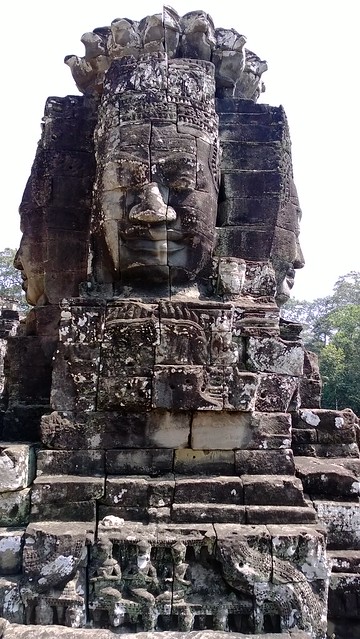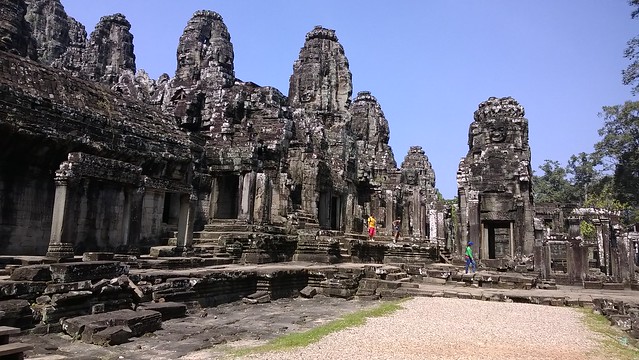Half-Day in Petra
We had one more day in Petra before our drive towards Amman and the Dead Sea area. We decided to visit the sites that we missed in
Day-2, and then also explore Wadi Rum. "Wadi Rum" is Arabic for "Valley of the Moon", and it is a desert landscape that looks similar to the moon. Actually, it looks closer to the surface of Mars, due to it's reddish rock, so the naming is not too accurate. Anyways, I contacted Omran (our tourist taxi guy), and he arranged for a drive to Wadi Rum in the early evening. We spent the first half of the day revisiting Petra.
 |
| Colorful Camels ready for the ride. |
The first place we headed to were the three rows of tombs called the "Royal Tombs" which we had
missed yesterday - the Urn Tomb, Silk Tomb, Corinthian Tomb and the Palace Tomb. These were named "Royal" tombs since they were of considerably large size, compared to the rest of the city.
 |
| Urn Tomb |
The Urn Tomb is the first o the right, as you walk from Al Khazneh. It is called so, because it has a carved urn at the top (similar to Al Khazneh and Ad Deir Monastery). The inside looks quite amazing, as the erosion pattern shows up like a rich design on the rocks. The Urn Tomb was later adapted as a Church during the Byzantine rule of Petra.
 |
| Alcove inside Urn Tomb. |
Next to this was the Silk Tomb - named so because of the erosion patterns of the rocks. Further down, there are two larger tombs - Corinthian Tomb and Palace Tomb. The Corinthian Tomb has been named so because of the Greek Corinthian style pillars, while the Palace Tomb is named so because it is the largest, and looks like a Roman or Greek period palace.
 |
| Corinthian (right), and (left) Palace Tombs. |
These monuments look a bit like the Al-Khazneh, but they are not so well preserved. It may be because these monuments were more exposed to the elements than the Al-Khazneh, which is sheltered by the Siq canyon.
By this time, the wind picked up a bit, and it was blowing the sand around everywhere. I purchased a keffiyeh scarf from an old Bedouin woman's stall for 5 dinars. It turned out to be quite useful, for protecting against the sand and the sun, and also was useful later in Wadi Rum. With my head wrapped up Bedouin-style, we headed to the Nabataen Theater.
 |
| Nabataen Theater |
With almost everything covered in Petra, we headed back to the visitor center. This time, we decided to ride horses on the way back. IMHO, it was quite a waste of money, and the horses did not look well kept. Still, it turned out as a good photo shoot for us, as the horseman ran ahead and clicked pictures on the way back!
At the visitor center, we had a good traditional lunch of Jordanian "mansaf". This is a dish made of rice with lamb simmered in yogurt, and garnished with parsley and pine nuts. The waiter told us that it's a traditional wedding dish.
 |
| Mansaf |
Valley of the Moon
Once back at our hotel, we contacted Omran, and sure enough, our ride to Wadi Rum was ready! Wadi Rum is a desert region in Southern Jordan, and is well known for it's other-worldly landscape. Several Hollywood movies, including Transformers, Prometheus, and The Martian, have been shot here, as the desolate landscape looks like the surface of Mars. We drove from Wadi Musa in a sedan, and our driver told us the recent history of Jordan, and the royal family. It was interesting, as he showed us each Jordanian currency had the portrait of some royal family member. We soon reached a gas station at the fringe of the desert, and, we were joined by Hussain, another driver, in a battered old Mitsubishi 4x4 pickup truck. The truck had converted it's bed into benches on each side, and we rode out into the desert on the open truck bed.
 |
| One solitary donkey in the desert. |
The truck drove into the desert, and the landscape really looked other-worldy, and it was quite apparent why Hollywood choose this as the location for alien planets!
 |
| Looks like an uninhabited planet in outer space! |
Further on, we saw a few camels grazing on desert scrub, so it was not really as desolate and devoid of life as it looked.
 |
| Camels. |
Hussain drove the truck near a rock cliff, and stopped. He told us that the cliff had ancient petroglyphs carved on it.
This was surprising, as it meant that man had inhabited this desert long
ago.
 |
| Wadi Rum landscape with our ride - the pickup truck. |
We were not sure how old these were, and Hussain also did not know, except the generic "a long time ago".
 |
| There were petroglyphs on this cliff face - at the bottom of the alcove-like formation to the right. |
We climbed up the cliff face for a closer look at this. The petroglyphs depicted a family - two adults and a child to the left. There was an inscription of two human feet between the adults and the child, and what could be a dog between the two adults.
 |
| Up close with the petroglyphs, with us for scale. |
Next up was a natural bridge formed out of erosion of the rocks.
 |
| Rock bridge. |
We then moved on from here to an open scrub area, where Hussain stopped the truck again, asked us if we would like a cup of tea. "What, out here?" was the first reaction, as there was not a single tea shop or restaurant for miles and miles.
 |
| We stopped here for tea! |
Hussain then proceeded to dig a small hole in the sand, behind a medium-sized desert bush, and gathered some dry twigs to light a fire. Sure enough, soon a kettle of tea was brewing in the middle of the desert!
 |
| Tea in the desert! |
We had an incredible experience, sipping tea as the sun set over Wadi Rum.
 |
| Sunset over Wadi Rum. |
This ended our trip into the Wadi Rum desert, and we headed back to our hotel in Petra. Our driver offered to take us to a traditional restaurant for a "Maqluba" dinner, but we were too tired to head out. Politely refusing the offer, we ate a quick in-room dinner, and called it a day.
The Dead Sea
The next morning, our old driver, Yousef, showed up at breakfast time. We checked out of the hotel in Petra, and headed off towards Amman. Our destination was the Dead Sea area of Sweimeh. The route took us through the Dana biosphere.
 |
| Dana Biosphere. |
The drive took about 3 hours, and soon we were driving alongside the Dead Sea.
 |
| Dead Sea from the cliffs along the highway. |
The Dead Sea is a bit of a misnomer, as it is really a large lake. While the lake it quite long, lengthwise, it is just about 10 kms wide, and you can see the shores of Palestine/Israel on the other side. It is also the lowest region on the Earth, at 400 meters below sea level.
 |
| Elevation level |
The "sea" is also extremely saline, and has no apparent marine life (hence the "Dead" in Dead Sea). We checked into our hotel - the Marriott Jordan Valley - and grabbed some lunch at one of their many restaurants. The hotel is very large and luxurious, and has a private beach area.
 |
| Hotel grounds - Jordan Valley Resort & Spa |
So far, we had been staying at a mid-range hotel in Jordan, and this was quite an upgrade! The hotel was spread out over a large area, had multiple outdoor swimming pools, and a spa. They even provided the famed "Dead Sea mud" which has several healing and medicinal properties. You are supposed to apply the mud, wait for it to dry, and then jump into the Dead Sea to wash it off!
 |
| Private beach area on the Dead Sea |
The experience of "swimming" in the Dead Sea was quite unique. The water feels almost like oil on the skin. One cannot really swim here, but just float on your back. The water is incredibly salty, as I found out when a little splashed into my mouth (you need to get out of the sea and rinse your mouth with fresh water if this happens). The buoyancy of the water is such that one cannot really sink, even if one does not know how to swim. However, people do drown in the Dead Sea if not careful. It is difficult to roll over in the water, and hence, if swimming a front stroke, one needs to be very careful not to get the head into the water.
 |
| A rose-gold sunset on the Dead Sea. |
We spent two days at this resort, swimming in the sea and their outdoor pools, and trying out the excellent Jordanian cuisine. It so turned out that they did make Maqluba - the same traditional dish that out Wadi Musa driver wanted us to try. We also had what could be the best falafel & hummus (as expected) for breakfast in this resort. The Dead Sea experience was a great way to end to our stay in Jordan. We flew back from Amman airport the third morning.



















































